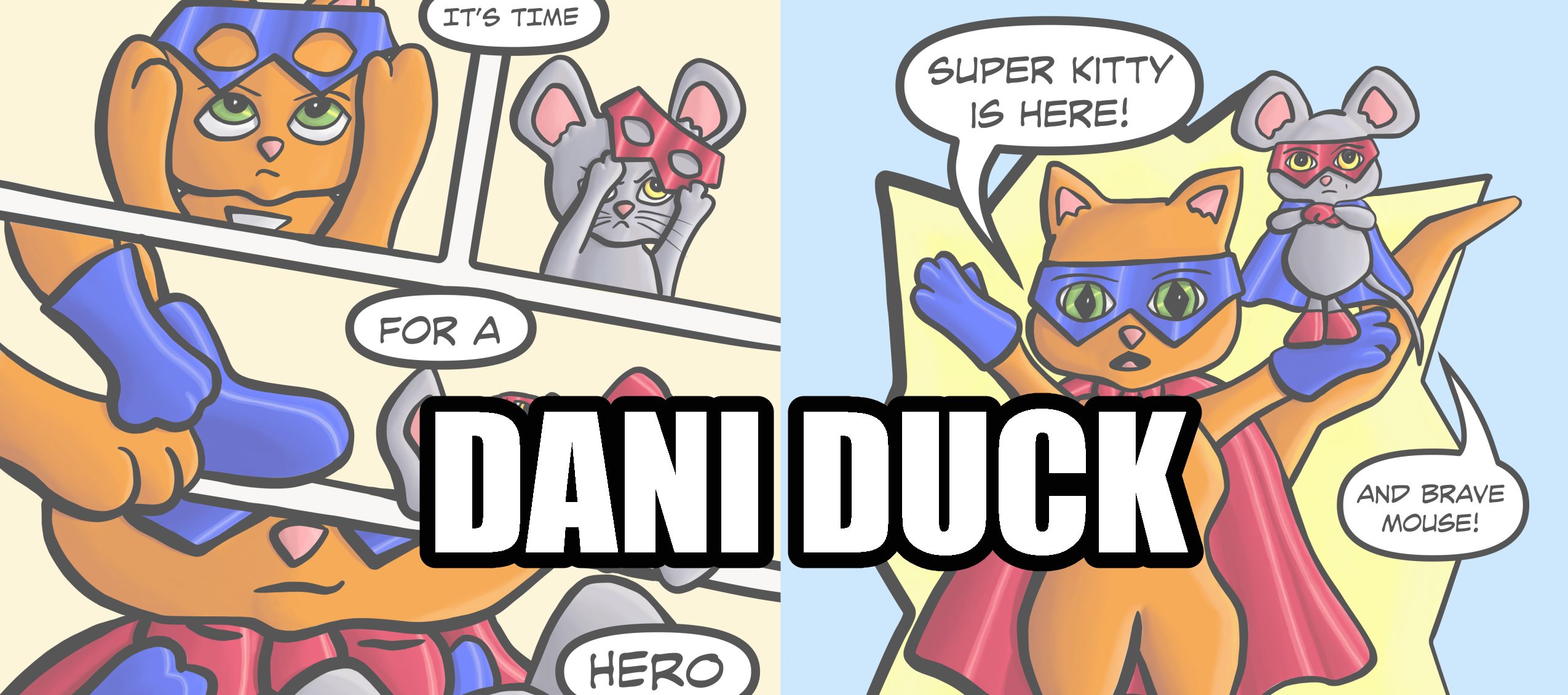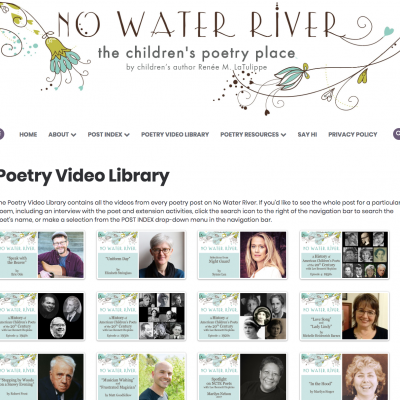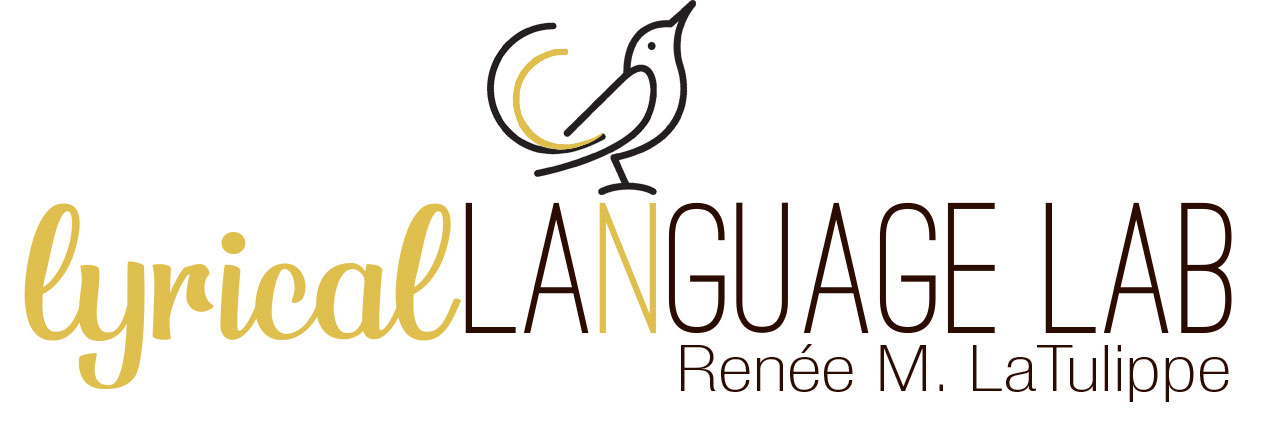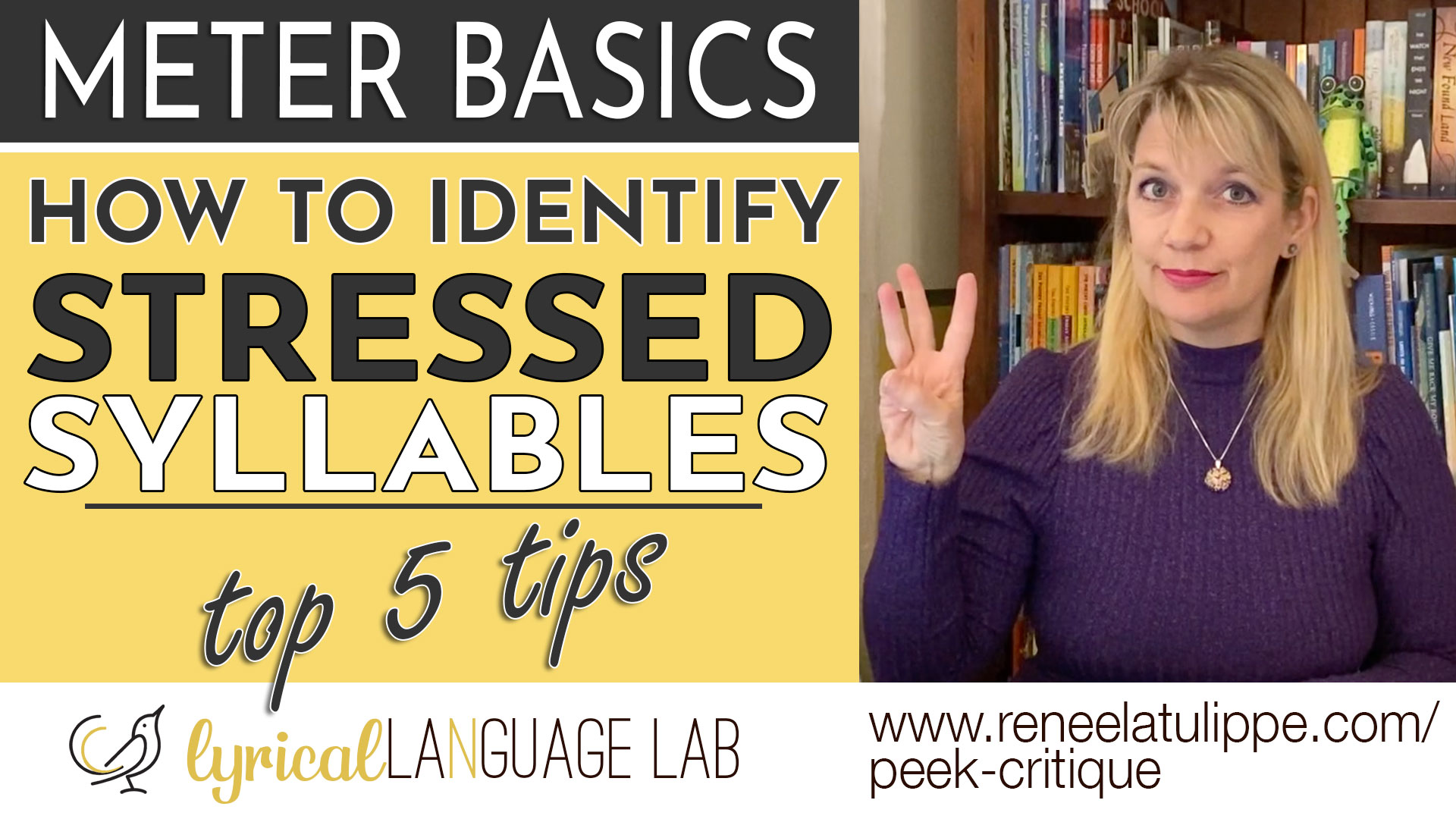Spring into Writing
-
A Look At the Week May 24th-June 1st
May 23, 2020 /It’s sadly the last full week of Spring into Writing! Since there is not much left to do after Saturday I’ll be going over the rest of the month through June 1st!
Monday, May 25th: Dawn Young starts off the week talking about fun with writing. Yes, she’s taking on the spirit of our event here and putting it into post format. Lots of fun little tidbits here you wont want to miss. Dawn’s Website: https://www.dawnyoungbooks.com/
Tuesday, May 26th: A list of some books released in 2020 from different authors!
Wednesday, May 13th: Lisa Chen-Wing shares a powerful post about the reasons to start a webcomic. She creates her own autobiographical webcomic called “Whiny Whiny Pancakes”. This comic is hilarious. Check it out and fall in love with Lisa’s comic: http://whinywhinypancakes.com/
Friday, May 15th: The superpowered Cyndi Marko talks about her life as an writer/illustrator. Her book collection just released in April. The fifth book in her Kung Pow Chicken series coming out in September 2020! She’s also got a lot of other books coming out, so you wont want to miss this interview! https://www.cyndimarko.com/
Monday, June 1st: End of Spring into Writing. Lots of crying and one last prize!
-
Rainbow Connection Robin Stevenson — Plus a Winner!
May 22, 2020 /While writing this intro for Robin Stevenson I can’t help but hear the song, “Rainbow Connection” in my head. It’s not just because I’m listening to the song while I’m writing. Robin just gives me all the warm feeling I get when I hear the song.
I wish that I had Robin’s books when I was a kid. I also wish that my parents and the world would have been supportive in me reading such books. It’s wonderful knowing that not alone in this world. I love that feeling and I know that Robin’s books will help our and future generations feel this way as well!
Robin’s Website: https://robinstevenson.com/
———–
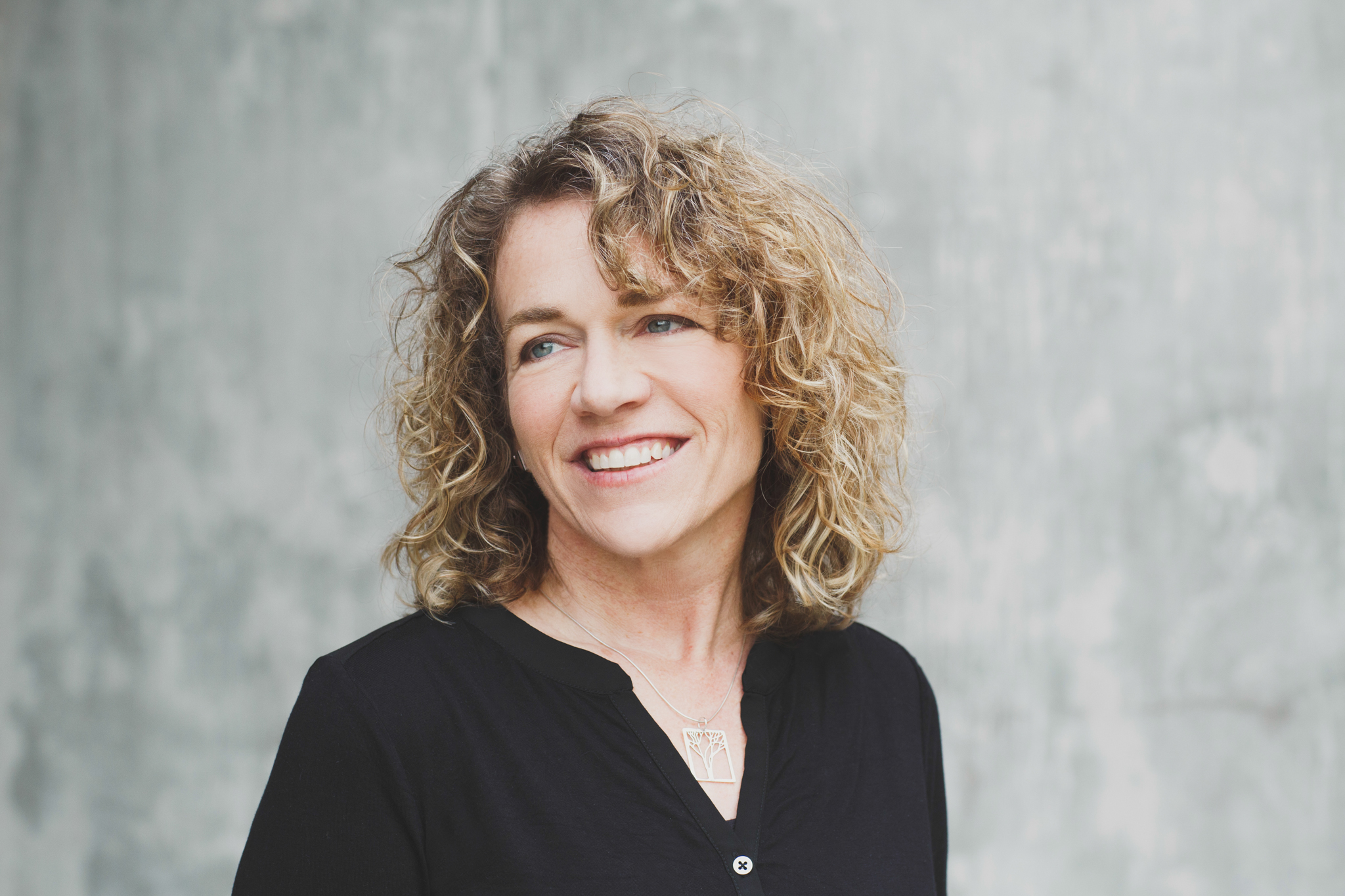
Photo of Robin Stevenson Hello! Hope you are all doing okay and finding support and ways to cope during this strange pandemic spring. Despite having lots of time due to cancelled tours, launches and events, I’ve been finding writing rather difficult lately…so I was glad to get an email from Dani asking me if I would share something about why I love writing about LGBTQ+ characters and themes in my books.
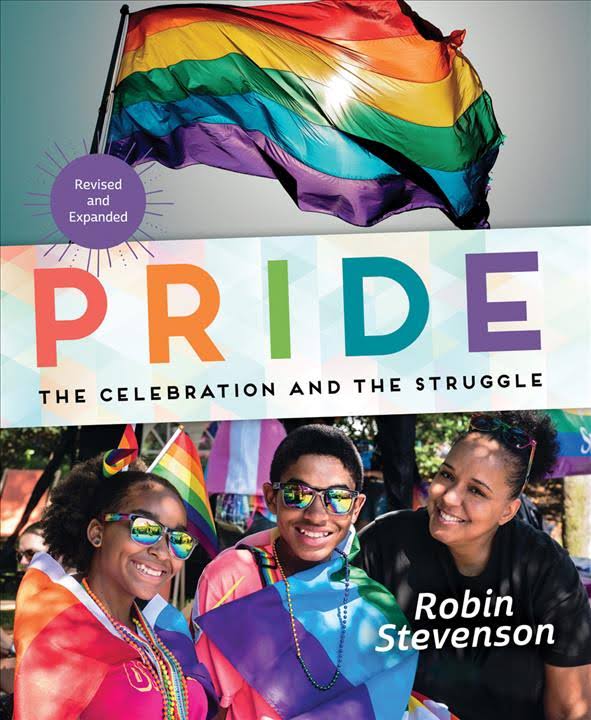
Pride The Celebration and the Struggle - Cover Over the last few years, I seem to have become known for writing LGBTQ+ books. My first non-fiction book, PRIDE: CELEBRATING DIVERSITY AND COMMUNITY (https://robinstevenson.com/books/pride-celebrating-diversity-and-community/), came out in 2016 and was a Stonewall Honor book. Many of my novels include LGBTQ+ characters and several, including INFERNO (https://robinstevenson.com/books/inferno/) and UNDER THREAT (https://robinstevenson.com/books/under-threat-2/), have been selected for the ALA Rainbow List. My board book PRIDE COLORS (https://robinstevenson.com/books/pride-colors/) is currently a Lambda Literary Award finalist, my picture book GHOST’S JOURNEY: A REFUGEE STORY (https://robinstevenson.com/books/ghosts-journey-a-refugee-story/) tells the story of two gay men and their cat, and this spring I launched a second, expanded edition of my original Pride book: It is called PRIDE: THE CELEBRATION AND THE STRUGGLE (https://robinstevenson.com/books/pride-the-celebration-and-the-struggle/).
(I was also going to launch my latest– and very queer– YA novel, WHEN YOU GET THE CHANCE (https://robinstevenson.com/books/when-you-get-the-chance/) , co-written with Tom Ryan, but due to the pandemic it will now be delayed until spring 2021).
So…why LGBTQ+ books? Well, when I wrote my first novel fifteen years ago, I drew heavily on my own experiences and memories of being a queer teen. Of course, that was a long time ago—I was in high school in the 1980s. It wasn’t a great time for queer teens: we didn’t talk about LGBTQ+ identities, we didn’t have books about LGBTQ+ characters, and many of us didn’t even have the language that might have made it so much easier to talk about these subjects, to understand our own identities, and to find community.
So my first novel, OUT OF ORDER (https://robinstevenson.com/books/out-of-order/), came from that place and those memories. It is about a bisexual teen, Sophie, who is just beginning to figure out who she is and how she wants to be in the world. After it was published in 2007, I began hearing from readers who related so strongly to Sophie—and I began realizing how important this kind of representation was. The following year, my novel BIG GUY (https://robinstevenson.com/books/big-guy/) came out. It was about a gay teen boy, and again I received emails from readers to whom this novel really mattered. One young gay man told me that he read it over and over– and that it helped him to understand and accept himself.
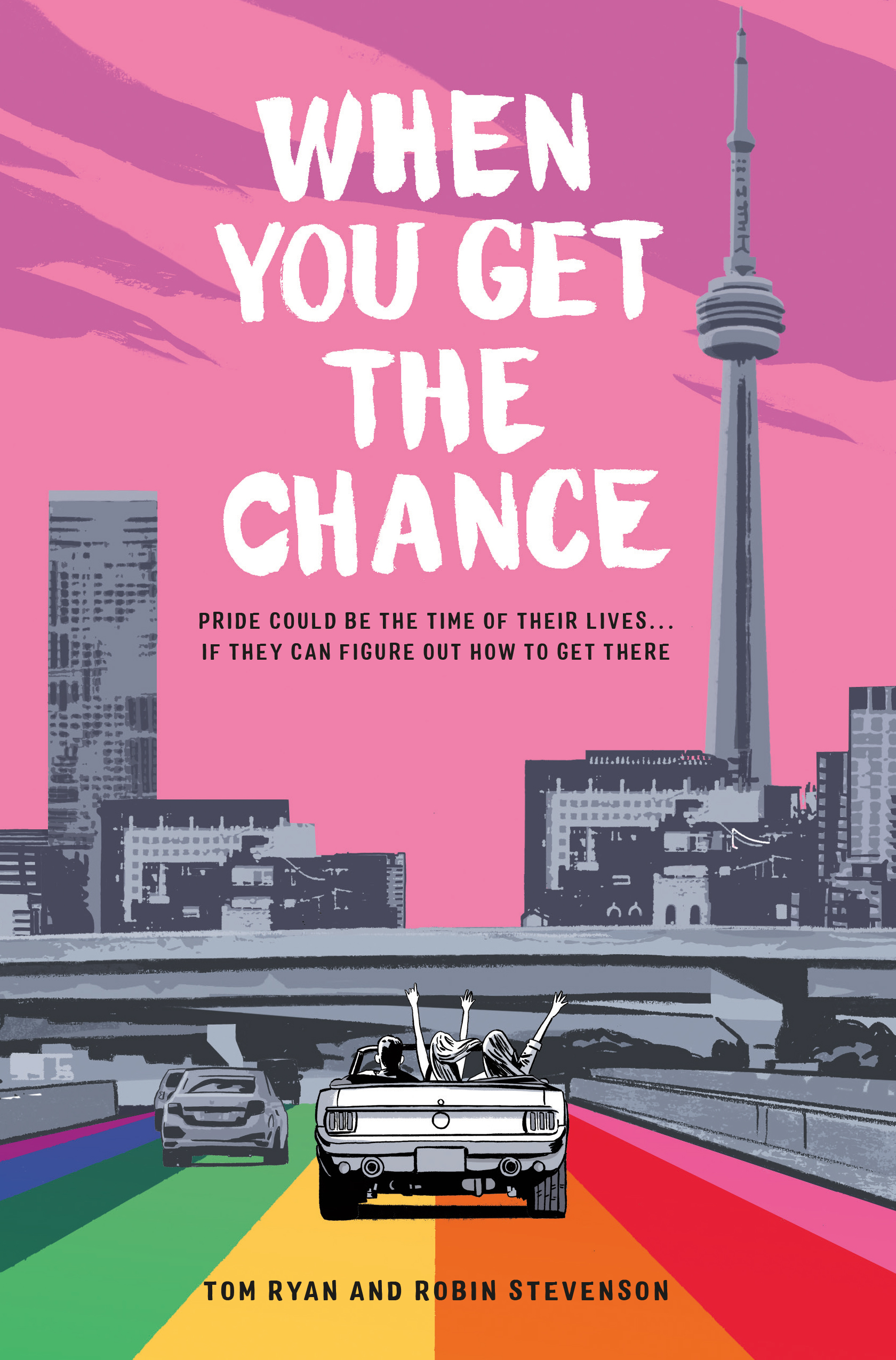
Cover of When You Get the Chance And of course, it isn’t just important for LGBTQIA+ kids and teens to see LGBTQ+ characters in books: I think all children, parents and teachers need these books. For young people who don’t know a lot about LGBTQ+ people, books can help them learn, have empathy, and hopefully care more about issues of human rights. Homophobia, biphobia and transphobia are still common, and they hurt people—and I think books can be an important part of working to change that.
Although I started out writing for teens, I have begun writing LGBTQ+ books for much younger kids as well. Things are getting better but when I visit schools and talk to students, I still meet many who are afraid that if they come out as gay, or bi, or lesbian, or trans, that their parents won’t support them, or will be angry or disappointed. So I think kids need to hear from the people that love them that it is okay for them to be themselves and to love who they love. Our teens and our older kids need to hear that, of course—but there is no age that is too young to begin giving your kids that message. So I wrote my board book, PRIDE COLORS (https://robinstevenson.com/books/pride-colors/), for the very youngest kids–babies and toddlers. I hope it gives parents an easy way to tell their children that it is okay for them to be who they are, love who they love, and that they will always be accepted and adored.
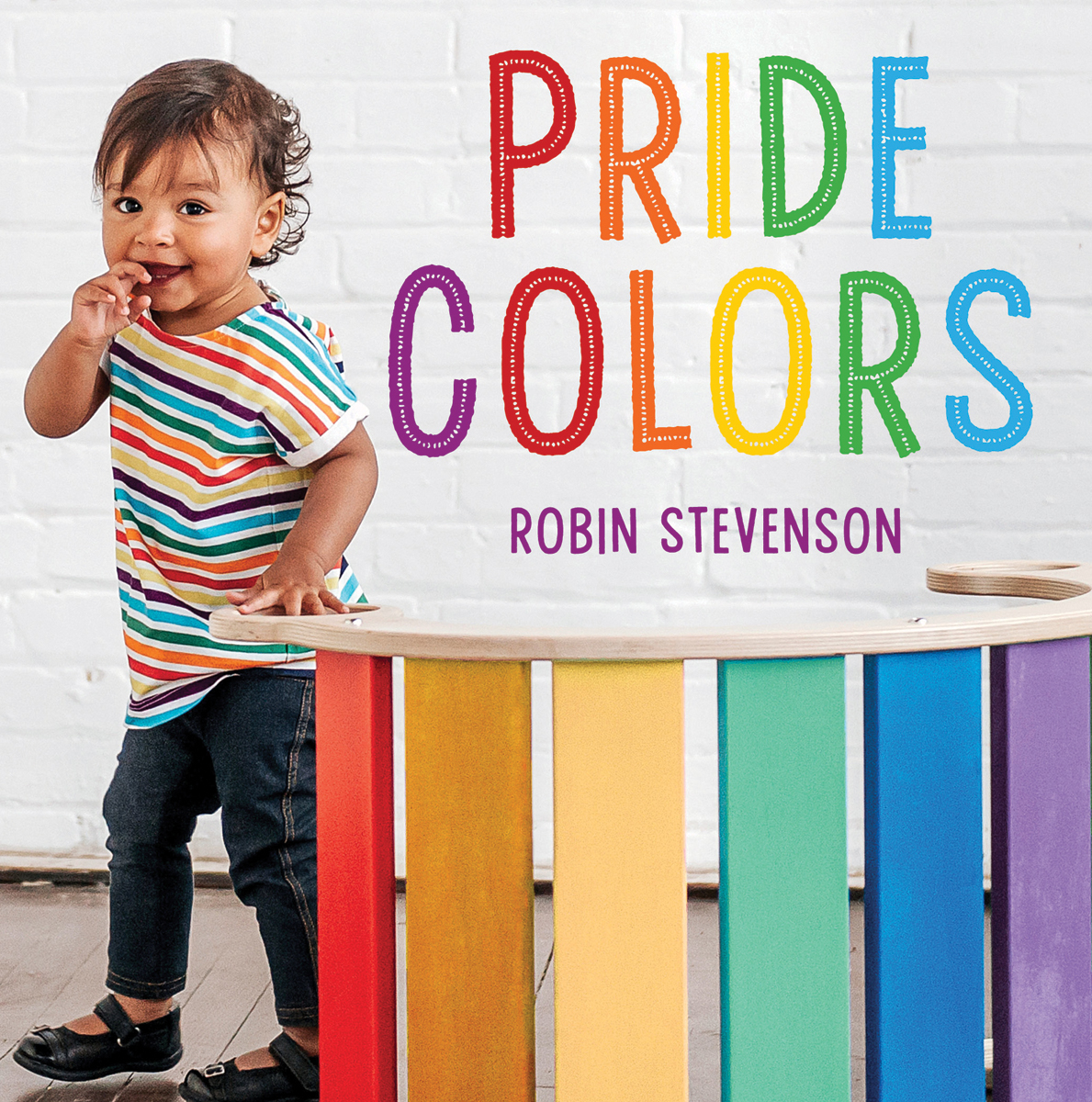
Cover of Pride Colors 
Cover of Ghost's Journey: A Refugee Story My picture book, GHOST’S JOURNEY: A REFUGEE STORY (https://robinstevenson.com/books/ghosts-journey-a-refugee-story/) , is for slightly older kids. It tells the story of two gay men, Rainer and Eka, who fled Indonesia and came to Canada as refugees—along with their cat, Ghost. It is based on a true story and the illustrations are created from Rainer’s photographs. I wrote it to raise awareness of the challenges faced by LGBTQ+ people around the world, and my hope is that it can be used in classrooms as a gentle introduction to human rights issues. All my royalties from this book go to support LGBTQ+ refugees—I am hoping it will raise funds as well as awareness!
Writing about LGBTQ+ history and rights has strengthened my own connections to the queer community. It has led to so many conversations with queer young people, peers and elders; taught me more about my community’s past and its ongoing struggles; made me part of a wonderfully supportive group of queer writers; and connected me with other LGBTQ+ people around the world. And of course, all of that makes it even more likely that my future books will include LGBTQ+ characters…because my writing reflects the world I live in.
I am curious about the stories and books that will come out of this current period in our lives. How will the pandemic and all we are experiencing filter into our writing? For myself, I am returning to a long neglected and half written mystery novel this week and am hoping that the words will start to flow again…wish me luck! For those of you that are also finding writing challenging this spring, I hope you will be gentle with yourselves and do what you need to do to cope. The words will come eventually. They always do.———–
Follow Robin:
Website: https://robinstevenson.com/
Twitter: https://twitter.com/robin_stevenson
Books: https://robinstevenson.com/books/
@%@%@%@%@%@%@%@%@%
WINNER:
The winner of the $25 gift card is Tonnye Williams Fletcher!
a Rafflecopter giveaway -
Delightfully Dark Dea Poirier
May 20, 2020 /Write What You Love
Dea Poirier is just delightfully dark. If I could name one Twitter feed that is just full of fun, it’s hers. Did I mention she’s hilarious? I laugh so much when I read her posts.
Dea didn’t always think of herself as dark. She tried several different genres before she found her place in the book world. Today Dea is going to talk about her journey to find herself.Dea has two books “Next Girl to Die” and “Beneath the Ashes”. These books have murder, mystery and lots of thrills. You can check out Dea’s website here: https://www.dhpoirier.com/
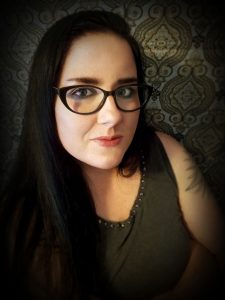
Photo of Dea 
Cover of Next Girl To Die There’s a bit of writing advice that will still echo through the ether long after we’re all gone — write what you love. It’s great advice, really. Something I think we should all use as our starting point when we put pen to paper. But there’s something more than love that needs to be considered, what’s in your heart. It’s not just love that exists there, there’s so much more.
When I started writing books—a thousand years ago—what I loved were historical books that had a lot of romance, fun fantasy books, oh and a lot of other books that are in no way representative of anything I could ever write. I thought I could craft books like the ones I loved, but the moment I tried, something very different came out of me.My first book was about a teenage version of God playing with the earth like it was an ant farm. He was super mean to the earth because he was bullied at school. Sounds like a fun premise, right? That is until you get to the villain—the dad that God didn’t know he had—that was literally destroying their planet by sucking the life out of it, and Earth was next. It got super dark, super fast.
Whoops. My second book, I ventured into trying to write a fun paranormal romance about a teenage psychic. What did I end up with? Well, this particular psychic’s gift involved her being able to see and feel the exact way that someone would die if she touched them. An evil stage mother made her famous off this gift, and a radical doomsday cult thought the psychic had to die for the end of days to come… SUPER FUN RIGHT? Oh, and her boyfriend was dying. Good job bringing all the fun, Dea.
Don’t get me wrong, I enjoyed writing these books, but every person that read them began comping my work with The Hunger Games and they’d always say first Wow, that’s really dark before saying anything else about it. Naive baby writer Dea had no idea why they were so dark.
This went on for years. I’d write a new book and get told it was too dark for the market. ALWAYS. I shifted to historical hoping for a better reception. I mean, if it’s dark because it’s historical, that’s fine, right? Nope. Then on to romance. Haha. I wish I knew what I was thinking. I finally found my stride when my agent at the time suggested that I try writing dark romantic suspense with troubled characters… and mystery is what ended up coming out. Not a single person has told me that Next Girl to Die or Beneath the Ashes are too dark, so yay. I’m hoping that one day a historical fantasy of mine might make it out into the world as well.
My journey through so many genres taught me that it’s not just about writing what you love, and it never can be. Darkness is what comes out when I write, it’s not something I seek out on purpose, but it’s the subtext in all my prose. It took me a long time—over ten years—to understand what it would take to find the balance of what I love and what’s in my heart. There are some parts of us we just can’t fight no matter how hard we try. Maybe I should have embraced the darkness sooner.
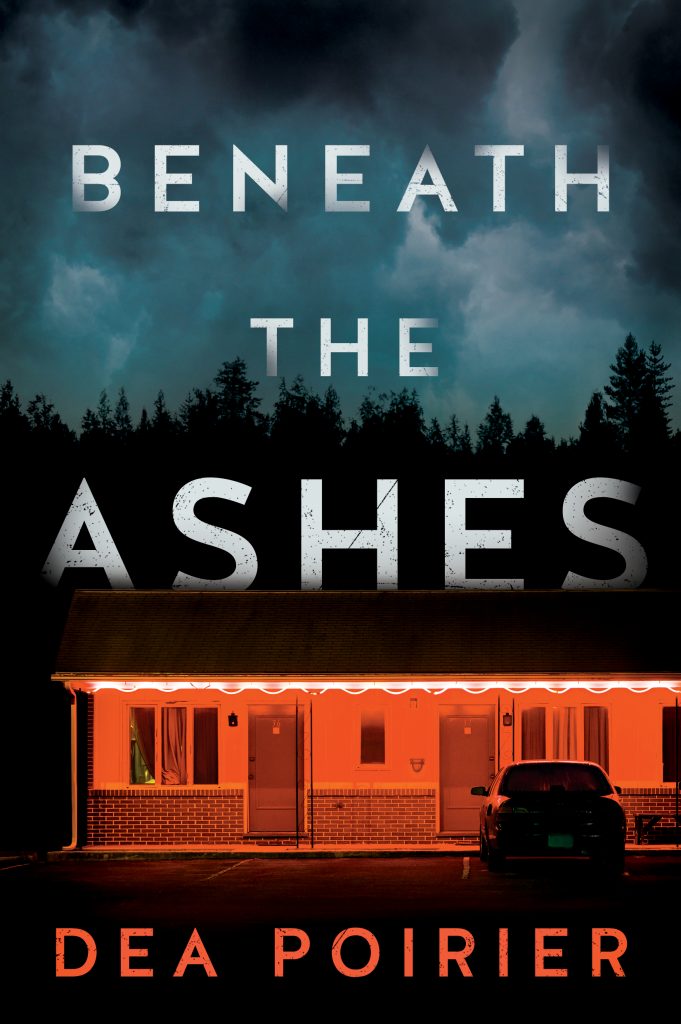
Cover for Beneath the Ashes Bio: Best-selling author, Dea Poirier was raised in Edmond, Oklahoma, where she found her passion during a creative writing course. She studied computer science and political science at the University of Central Oklahoma. She later spent time living on both coasts and traveling the United States before finally putting down roots in central Florida. She now resides somewhere between Disney and the swamp with her son. Her books Next Girl to Die and Beneath the Ashes can be found wherever books are sold.
Website: Dhpoirier.com
Twitter: https://twitter.com/deapoirierbooks
Find my books: https://www.amazon.com/Dea-Poirier/e/B07GNVZ9RK?ref_=dbs_p_ebk_r00_abau_000000
-
Sharon Giltrow, Digital Trailblazer
May 18, 2020 /Right now it’s a difficult world for everyone. Sharon Glitrow is one of the authors who has had to release their books during a pandemic. She has written a wonderful picture book called BEDTIME, DADDY. Sharon is here today to talk about releasing her book during this pandemic. Lots of great information for both people releasing books now, and in the future where a digital launch may be just a bonus.
You can visit Sharon’s website here: https://sharongiltrow.weebly.com/about.html
Releasing a Book During a Pandemic
By Sharon Giltrow
Covid-19 has forced all of us to make major changes to our daily lives. We have all had to find ways to do things differently, to adapt and change. My debut picture book BEDTIME, DADDY was released this month, May 1st, through EK books.
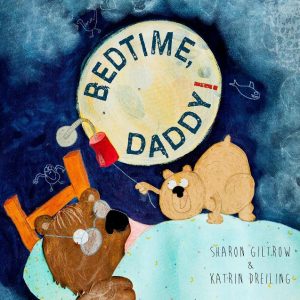
Cover of BEDTIME, DADDY! When I signed the publishing deal for BEDTIME, DADDY back in August 2018, I could never have imagined that twenty months later a pandemic would be sweeping the world. As a result, I have had to adapt and change the way that my book is being released and promoted.
My in-person book launch for BEDTIME, DADDY was booked for June 21st (Father’s Day in the Northern Hemisphere). My favourite book shop in Fremantle, Western Australia, Paper Bird Children’s Books and Arts, was going to host the event. However, as a result of the required and essential Covid-19 social distancing rules, my in-person book launch became a virtual book launch.
On May 1st, 2020, via Paper Bird’s live Instagram, from the comfort and safety of my own home, I launched my book BEDTIME, DADDY. I still wore my favourite dinosaur pyjamas.
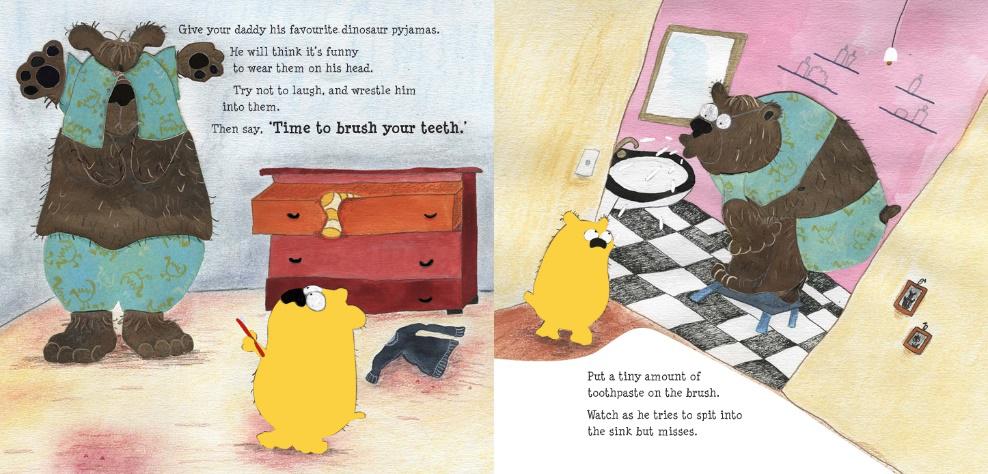
Interior of BEDTIME, DADDY! "Time to Brush Your Teeth." I still had an audience, my immediate family, as well as family and friends from around the world. There were still fun activities from BEDTIME, DADDY. Signed copies of BEDTIME, DADDY were still available through Paper Bird’s online store, and signed book plates were posted around the world. Cakes and cookies were still eaten at the end of the launch. So, despite the world-wide pandemic my book launch still happened, just in a different way. Actually, I may even have had more people at my virtual book launch as people from all over the world ‘attended’ through Instagram. Here is how I promoted my book launch on social media.
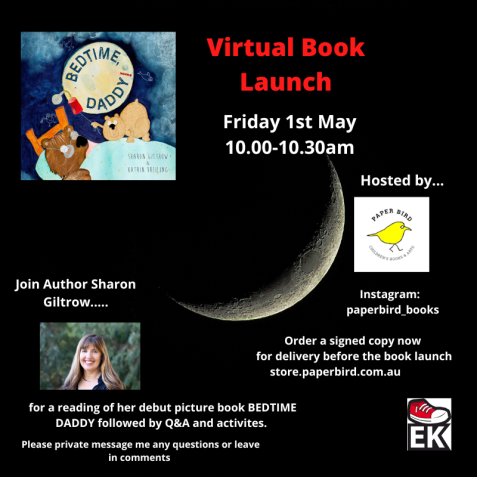
Virtual Book Launch Poster In-person book readings, signings and story times were also now out of the question. So, my publisher EK Books asked me to do a sneak peek read aloud of BEDTIME, DADDY on YouTube. I quickly upskilled myself in selfie-videos and found out that it is tricky to hold up a book and read naturally even though you can see yourself the whole time. But by the end of the fiftieth take, I finally got the hang of it.
My publisher also asked me to do a radio interview on ABC – Radio National, but I couldn’t go into the studio. So, with the help of Voice Memos, a script I prepared, and my family, I was able to record the interview and email it to the radio station.
My next challenge, with book shops now closed – How would readers discover BEDTIME, DADDY? The answer, online. Online book shops are now the main place to sell books so I stepped up my online presence through Twitter, Instagram and Facebook to let readers know that BEDTIME, DADDY existed.
School visits are now on hold, but I have been sharing links to BEDTIME, DADDY’S teaching notes, for parents who are home-schooling and educators who are preparing online lessons. They can be found on EK Books and SCBWI – Australia West websites. I will also be recording and sharing short videos of some of these activities.
Finally, as travelling is now out of the question, instead of going on an in-person book tour around Australia and possibly the world, I created a BEDTIME, DADDY blog tour,which can be found on my website. My book and I are now touring around virtual space.
I hope that through this blog I have shown you that despite a world-wide pandemic, books can still be successfully released and that now more than ever they need to be released, purchased, read and shared.
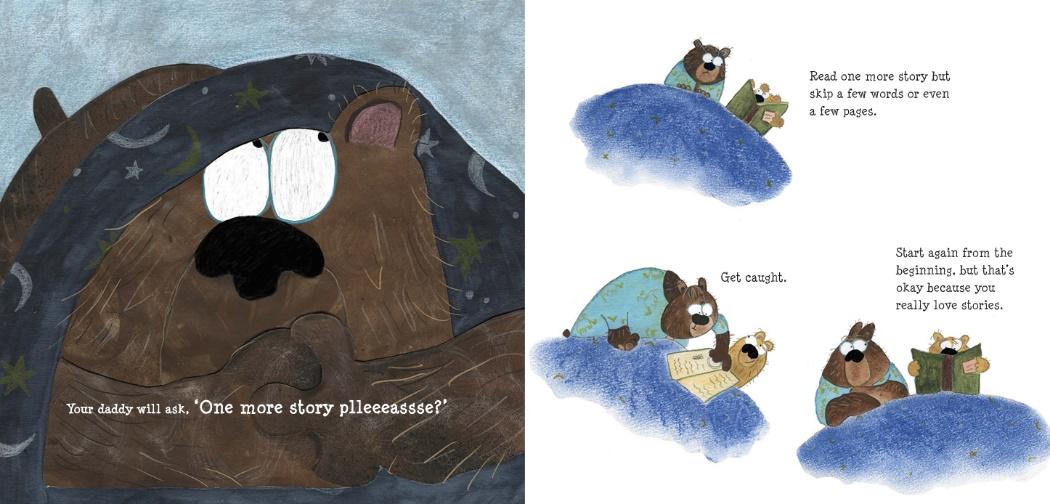
BEDTIME, DADDY! Interior Page: Your Daddy Will Ask, "One more story pleeeassse?" Sharon Giltrow grew up in South Australia, the youngest of eight children, surrounded by pet sheep and fields of barley. She now lives in Perth, WA with her husband, two children and a tiny dog. When not writing, Sharon works with children with Developmental Language Disorder. Sharon was awarded the Paper Bird Fellowship in 2019. Her debut PB BEDTIME, DADDY, released May 2020 through EK books.

Follow Sharon:
Website: https://sharongiltrow.weebly.com/
Twitter: https://twitter.com/sharon_giltrow
Facebook: https://www.facebook.com/sharongiltrowwriter/
Instagram: https://www.instagram.com/sharongiltrow1
Buy BEDTIME DADDY:
From the Publisher: https://ekbooks.org/product/bedtime-daddy/
From Amazon:
USA: https://www.amazon.com/Bedtime-Daddy-Sharon-Giltrow/dp/1925820386UK: https://www.amazon.co.uk/Bedtime-Daddy-Sharon-Giltrow/dp/1925820386
Austrailia: https://www.amazon.com.au/Bedtime-Daddy-Sharon-Giltrow/dp/1925820386/
-
A Look At the Week: May 17th-23rd
May 16, 2020 /A Look At the Week May 17th-23rd
Monday, May 18th: Sharon Gilthrow had the unfortunate luck to have her book released during a major lock down. See what she did to overcome the problem of a book launch while at home. Read about her digital release and her beautiful new picture book “Bedtime, Daddy!” https://sharongiltrow.weebly.com/
Wednesday, May 20th: Dea Poirier loves to write deliciously dark murder mysteries. She didn’t always write in that genre. See where Dea started and how she found her voice. Her books Next Girl to Die and Beneath the Ashes are to die for! https://www.dhpoirier.com/
Friday, May 22th: Robin Stevenson is all about pride. She’s making the world better one rainbow at a time! Robin’s non-fiction books cover important topics such as Pride, children who are activists, refugees, abortion rights and that’s just her non-fiction. Her books include Pride: The Celebration and Struggle, The Summer We Saved the Bees and Blood on the Beach. https://robinstevenson.com/
Saturday, May 23 A Look at the Week May 24th- June 1st. A couple extra days in there to end off our Spring into Writing event!
-
Lyrical Lovely Renee La Tulippe
May 15, 2020 /I have learned so much about rhyming from Renee La Tulippe! She has a wonderful Youtube channel called the Lyrical Language Lab that gives all kinds of information, tips and tricks for writing in rhyme! For those who just want a touch of rhyme in their prose, Renee is great resource for that too (and so much more)! I personally am not great with writing poetry, but Renee does such a fantastic job that I can’t help but absorb the information she gives. I asked Renee for an interview so I could find out more about rhyme!
To visit Renee’s website go here: https://www.reneelatulippe.com/
———-
Dani: Where should writers start if they want to learn to write rhyming picture books
Renee: There’s a lot of craft involved in writing a rhyming picture book, so here are my top three tips for learning to write them well:
1. If you are brand new to the world of rhyming picture books, start by reading a WHOLE LOT of them! I know kidlit writers and children’s poets who read for a full year before even picking up a pen. They immersed themselves in the genre, studied the structure, typed out texts and picked them apart, and really delved into the author’s craft. Reading widely is the best “course” you could possibly take! And if you’re NOT brand new … keep reading a WHOLE LOT of books in your genre and out of it.
2. Read, write, and listen to poetry, remembering that poetry and rhyming picture books are two different things. There are hundreds of amazing poets for young people out there, and adding a healthy dose of good poetry to your reading diet will do wonders for your imagination and your craft. I have an entire blog and video library dedicated to children’s poets at NoWaterRiver.com as well as a Big List of Children’s Poets That’s a great place to start!
3. Once you have a feel for how rhyming picture books work, I always suggest taking a “how to write a picture book” class — and the one that I most recommend is Susanna Hill’s Making Picture Book Magic. I think comprehensive feedback on your work is essential, and I have made it an integral part of my own course. It’s especially important when you’re just starting out, and Susanna’s class is the only one that I’ve personally taken that offers helpful, in-depth feedback every step of the way. I also suggest that people take this kind of class before taking my course because the former is a how-to on the big-picture concepts of writing picture books (story arc, plot, character development, etc.), whereas my course focuses on the language itself. Another great resource is Ann Whitford Paul’s classic how-to, “Writing Picture Books.”
Dani: What’s the biggest mistake that rhyming picture book writers make?
Renee: Writing rhyming picture books is notoriously difficult to do well and can bring even experienced writers to their knees. I’d say there are three major areas that often present problems in rhyming texts:
- The rhyme dictates the story. The story and characters are suffocated by the constraints of verse and have no breathing room to develop organically. The result is a weak story that wouldn’t hold up if written in prose.
- Inexpert meter. The rhythm is uneven, inconsistent, and choppy so that the reader stumbles, or it is so sing-songy that the reader gets bored. Worse, stresses are forced onto the wrong syllables just to “get the meter to work.”
- Tired and forced rhymes. The rhymes are uninspired and cliché and/or exist just to make a rhyme and add nothing to the story and/or don’t make sense.
So what is a writer to do? We can make sure our rhyming manuscripts are exceptional. That means studying the genre, reading successful rhyming texts, taking classes to learn the craft inside out, seeking expert feedback on our work, revising over and over, and even asking ourselves honestly if the story would indeed be better served by being written in prose.
Dani: What’s your favorite way to relax?
Renee: Making things! It doesn’t really matter what it is, as long as I’m creating something. I dabble in lots of things—sculpting with Sculpey clay, designing and sewing costumes, building or refinishing furniture, stenciling my walls, baking, or even creating graphics in Photoshop or editing videos—all of these activities produce something and require some level of creativity.
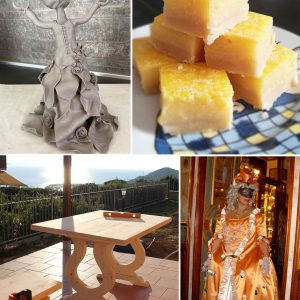
Renee's Projects I particularly love working with my hands because I enter some inner world where nothing else exists. When I’m thoroughly involved in a project, I can go hours and hours without eating or speaking to anyone. I don’t even listen to music—I’m just there inside my head and at total peace.
Dani: Can you tell me a bit about the course you teach?
Renee: Of course! It’s the Lyrical Language Lab, a course I developed and have been teaching since 2014.
As I briefly mentioned above, this is a language-level course that focuses on the craft of writing at the sentence level, including word choice, imagery, sound devices, rhyme, and meter. The course is geared to children’s writers and focuses on how to use poetic techniques in types of writing, both prose and verse, to make the writing more musical and engaging.
Although I only teach the fully-guided course once or twice a year, there are two self-study options available as well.
Dani: Do you have any news you’d like to share?
Renee: I do! I started a FREE resource for kidlit writers and I’d love to invite your readers to check out my Lyrical Language Lab YouTube channel Every Monday I offer short writing lessons on various concepts that are covered in my course.
I have several video playlists for the different things I cover:
- Peek & Critique – I offer my feedback on short writing samples sent in by viewers. You can submit your own writing sample right here.
- BookLook – My analysis of various lyrical language concepts and poetic techniques in picture books
- Meter Basics – The down-and-dirty techie stuff behind writing verse that flows
- Lyrical Prose 4-part series
- Revision – Real-time revision on submitted work and behind-the-scenes looks at my own revision process (in the works)
I hope your readers will take advantage of this free service!
About Renée M. LaTulippe
Renée has poems published in many anthologies including ThankU: Poems of Gratitude (ed. Miranda Paul), School People (ed. Lee Bennett Hopkins), the National Geographic Book of Nature Poetry and The Poetry of US (ed. J. Patrick Lewis), One Minute Till Bedtime (ed. Kenn Nesbitt), Poems Are Teachers (ed. Amy Ludwig VanDerwater), The Poetry Friday Anthology Middle School, Science, and Celebrations editions (ed. Sylvia Vardell and Janet Wong), and the forthcoming Night Wishes (ed. Lee Bennett Hopkins). Her debut poetry collection was acquired by Charlesbridge.
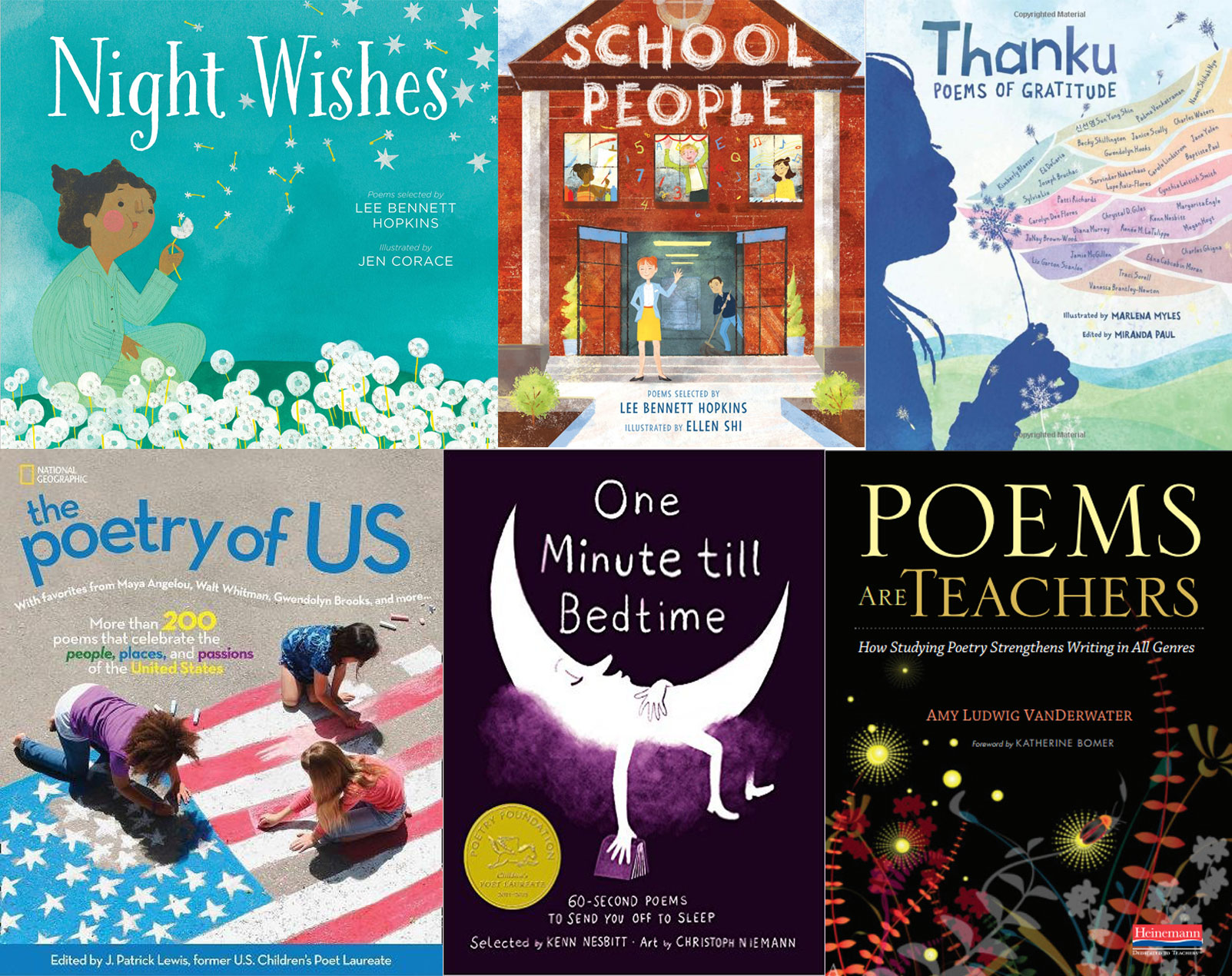
Anthologies that contain Renee's work Renée developed and teaches the online course The Lyrical Language Lab: Punching Up Prose with Poetry and blogs on children’s poetry at NoWaterRiver.com. She earned her BFA in acting/directing from Marymount Manhattan College and her MA in English Education from NYU; worked and played in the theater for almost two decades; and taught English, theater arts, and public speaking in NYC. She now lives by the sea in Italy.
Renée is represented by Elizabeth Harding of Curtis Brown, Ltd.
WEBSITE: reneelatulippe.com
Lyrical Language Lab: https://www.reneelatulippe.com/writing-courses/
YOUTUBE: Lyrical Language Lab Channel
BLOG: www.NoWaterRiver.com
- The rhyme dictates the story. The story and characters are suffocated by the constraints of verse and have no breathing room to develop organically. The result is a weak story that wouldn’t hold up if written in prose.
-
Writer of Wonder Helena Ku Rhee
May 14, 2020 /It’s always fun finding new writers. While visiting Cythia Mackey’s website I read the most wonderful interview with Helena KuRhee. I fell in love with the idea behind the story of Helena’s new book: The Paper Kingdom! I had to find out more about this story about Helena herself.
To read more about Helena visit her website here: http://helenakrhee.com/
—————

Finding Magic and Wonder Around You
by Helena Ku Rhee
I have a rare gift: I’m never bored. Even as a child, I rarely complained of boredom. I wasn’t born with this gift. Instead, it was cultivated in me by two amazing people: my parents.
When I was little, my parents worked as night janitors in a corporate building in L.A. And on nights they couldn’t find a babysitter for me, they took me with them to work, where they turned drudgery into magic. They told me funny stories about the people who worked in the offices by day, and helped me imagine a fantasyland in that empty office building. Thanks to them, I had early practice in the art of finding fun wherever I found myself. I wrote a children’s book about that time in my life, The Paper Kingdom, and it was released by Penguin Random House in early 2020. More info here: http://bit.ly/2IRw8Ti
NPR interviewed me and illustrator Pascal Campion about our book, The Paper Kingdom. The interview is all about finding magic and inspiration. You can listen to the 6-minute interview here: https://www.npr.org/2020/03/14/815250760/behold-the-magic-of-take-your-child-to-work-night
And I’ll let you in on a little secret: this gift of mine can be cultivated in all of us. How? Well, we hear phrases like “be in the now” or “live in the present.” But the key question is: how do you do this on a practical level, on a day-to-day basis?
I’ll give you one concrete example. When I take my dog Sherwin on an early morning walk, I explore the neighborhood like a writer, hungry for sensory details that I can later use in my stories. I stop to observe the shape of shadows on the sidewalk from a neighbor’s tree. If my dog yanks on the leash to chase a squirrel, I take note of the burn of the leash in my hand, the strain of the muscles in my arm (these descriptions could be used in an action scene). And I try to listen for different layers of sound – the birds gossiping in the trees, an airplane flying overhead, music filtering out from a home. I smell lawns being mowed, the roses blooming near the sidewalk, the exhaust from a car zooming past. I’m hungry for these details because I know they’ll be useful when I sit down at my computer. In other words, my brain is engaged and I’m not bored.
While I write this, our world is going through a very tough time due to Covid-19. We’re all so grateful for first responders and all those keeping our cities safe, clean, and livable. But people stuck at home may be bored and restless. Perhaps they’re stressed and filled with anxiety. So I get it. It’s not easy to fend off boredom when you’re trapped inside day in and day out. And it’s not so easy to take great interest in the shape of clouds, the sound of rain, the taste of dark chocolate when your mind is filled with worries.
But I hope that no matter the circumstances, you manage to see magic and wonder in this amazing world. If you’re an aspiring author, that ability is a gift that’ll serve you well with your stories.
Helena Ku Rhee is a writer based in Los Angeles. You can read more about her books and writing process here: http://helenakrhee.com/
And if you want to keep posted about Helena’s events and news, subscribe here: http://eepurl.com/cPRrL5 All new subscribers will receive a free dreams-to-reality worksheet Helena put together to achieve her writing dreams. (You can use the worksheet for any goal you may have.)
————
You can also follow Helena on Instagram (@helenakurhee), Twitter (@HelenaRhee) and Facebook (Helena Ku Rhee).
Each link has a list of places to buy Helena’s books!
The Paper Kingdom: http://helenakrhee.com/books/the-paper-kingdom/
The Turtle Ship: http://helenakrhee.com/books/the-turtle-ship/
-
The Mighty Intisar Khanani –Plus a Prize!
May 13, 2020 /Some writers get all the luck. Intisar Khanani has the luck of being given a magical name! Her name (pronounced just as it looks) is perfect for a fantasy writer. Intisar loves writing fantasy books with strong female leads. She had me at her name. Today she’s going to talk about mighty girls and I’m so here for this post!
You can read more about Intisar and her work here: http://booksbyintisar.com/
Look below this post for a prize!
————

Photo of Intisar Writing Mighty Girls
Intisar Khanani
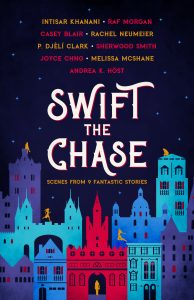
When I was a young teen, it was almost impossible to find stories in my chosen genre—fantasy—with strong female leads. When I stumbled across Tamora Pierce’s Alanna books, and Robin McKinley’s Damar books, it was like I had finally found stories that called to me. These were girls who stood up and fought for themselves, their people, and those they loved. I was over the moon, and continued to eat up stories of mighty girls as the years passed. I’m forty now, and YA fantasy is still my bread and jam: what I always come back to, and what I write.
But my conception of what makes a girl mighty has developed over the years, and in many ways departed from where it began. The idea of a girl being mighty because she excels in a man’s world by doing what a man would, only better, is one conception of mighty, and frankly, it’s needed. Absolutely women can kick butt as well as men, in pretty much any given sphere, whether it’s politics or sorcery or sword fighting (admittedly, if she’s of a smaller stature, the type of sword and her technique will differ).
The trouble is that we’re still playing by the male perspective; creating a valuation of “mighty” as excelling in a male-gendered conception of power. In such a world, being kind or compassionate or merciful are considered feminine and weak. And that does all of us a disservice, especially our young people. Why can’t you save the world, or yourself, through compassion? Through non-violent resistance and a nuanced understanding of mercy, rather than by the sword? Can’t both be considered mighty?
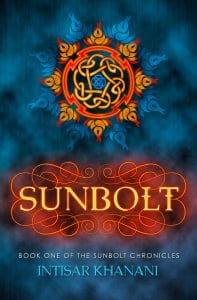
In my novel, Thorn, I have a young girl who must face both betrayal and a terrifyingly capable magical enemy without herself turning into a ninja or a sorceress. Instead, she must lean into her own personal strengths, and learn to carry the day through her courage, kindness, and intelligence. She is mighty, but not in the typical sense. And her story, I hope, will speak to all of us who can’t hope to win by turning into something we aren’t already.
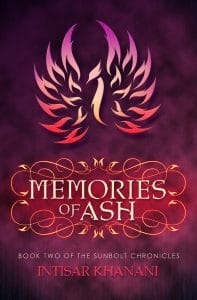
As you go forward in your writing adventures, I urge you to consider writing mighty girls who are mighty in who they are—whatever that means for that particular character—gaining power and the ability to influence their story through the inherent might in being true to one’s best self. This is how we win each day, this is how we build better lives, this is how we change the world.
Let’s get writing!
————
Follow Intisar:
Website: http://booksbyintisar.com/
Twitter: https://twitter.com/BooksByIntisarFacebook: https://www.facebook.com/booksbyintisar/
Buy Intisar’s books:
Buy Thorn: https://www.barnesandnoble.com/w/thorn-intisar-khanani/1111104034?ean=9780062835703
For other links to Intisar’s Thorne and other books start here: http://booksbyintisar.com/books/
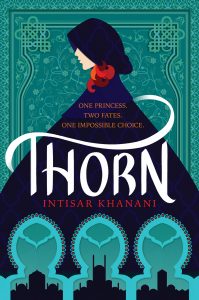
@%@%@%@%@%@%@%@%
Prize:
One lucky winner will get some website help from Dani Duck. I will review your current website and give you tips to make your site better. If you don’t have a website I’ll help you in setting one up! This includes a 1 hour zoom/email chat to set things up.*
To enter:
Comment below: Let Intisar know about your favorite fictional (or non-fictional) mighty girls! Or comment on anything she’s written about in this post.
Also let me know that you want this prize!
*Prize must be claimed within 30 days of it’s announcement and used within 6 months.
-
How to Hilarity with Henry Herz
May 11, 2020 /Henry Herz is a hilarious writer. If you aren’t following him on social media you should. You will get a great lesson on what it means to be funny, because his posts are hilarious! Henry has written a bunch of humor books for kids. He has done a lot of speaking events including school visits, conferences and conventions! Today he’s talking about the nuts and bolts of humor writing. You can visit Henry’s website here: http://www.henryherz.com/
Writing Humor
by Henry Herz
Those of you who follow me on social media know that I like to make humorous responses to other people’s posts. Wisecracking comes to me spontaneously. But when Dani asked me to write a blog post, I had to use the analytical side of my brain. So, fair warning: I’m setting your expectations right now. This post about humor will not be funny at all – barren of banter, a wilderness of wisecrackery, and a desert of drollitude. If you want to get up and leave now, no one will think less of you.
There are many different ways to achieve humor. But there is no specific formula for humor, particularly given how context-sensitive it is. This is by no means a comprehensive list of techniques. But these examples from picture books are intended to light a fire of farce, provide a comic catalyst, and spark some silliness.
1. Thwarting Expectations – Give the readers something they weren’t expecting. Jean Reagan’s HOW TO BABYSIT A GRANDMA offers a good example of the humor of role reversal. Ditto CHILDREN MAKE TERRIBLE PETS by Peter Brown. The following image from my MONSTER GOOSE NURSERY RHYMES shows a Muffet who, unlike the original, is not at all afraid of spiders.

2. Bodily Functions – Sigh. It may be low brow, but you can always rely on the Three-B’s of bodily functions (burps, barf, and boogers) to deliver disgusting delight. Consider the anatomical appeal of Taro Gomi’s EVERYONE POOPS or Kotzwinkle and Murray’s WALTER THE FARTING DOG.
3. Wordplay – English is a complex and nuanced language, providing fertile ground for authors to plant puns and sow idioms. While Dad jokes can sometimes be too subtle for younger readers, they also create language learning opportunities. Examples of this include Tara Lazar’s 7 ATE 9 and my GOOD EGG & BAD APPLE.
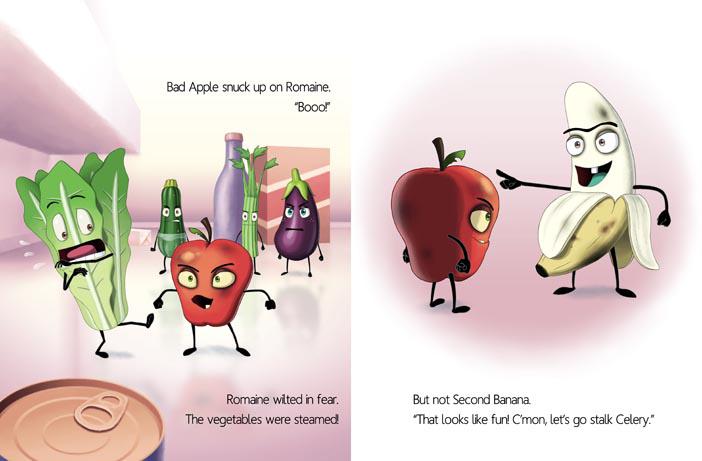
4. Made-up Words – In the tradition of Lewis Carroll’s Jabberwock poem, authors can create their own words. Just take care to provide sufficient context that young readers can figure out what you intend. Examples of this include Antoinette Portis’s BEST FRINTS IN THE WHOLE UNIVERSE and Carson Ellis’s DU IZ TAK?
5. Physical Comedy – Even though the author may not be the illustrator, you can write a scene in such a way that it will involve physical comedy. Examples include Dr. Seuss’s THE CAT IN THE HAT, Judy Schachner’s SKIPPYJON JONES, and my HOW THE SQUID GOT TWO LONG ARMS. Yes, that squid is wearing a stolen sweater.
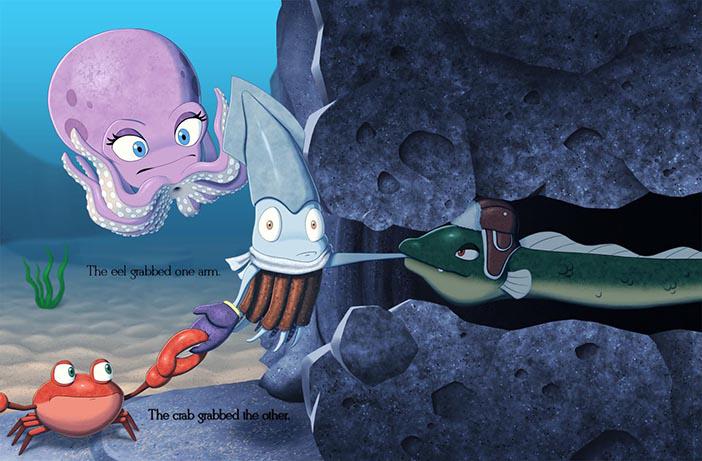
6. Absurdity / Exaggeration – Creating ridiculous characters or situations where things are taken to an extreme are great ways to induce a smile. Examples include Doreen Cronin’s CLICK CLACK MOO: COWS THAT TYPE, Mac Barnett’s PRESIDENT TAFT IS STUCK IN THE BATH, and Ryan Higgins’s MOTHER BRUCE.
7. Universality of Humanity – This is the opposite of thwarting expectations. Creating characters that behave in a recognizable way can also bring a laugh. Consider the realistic voice of the crayon characters in Drew Daywalt’s THE DAY THE CRAYONS QUIT or the realistic behavior of the little red chicken in David Ezra Stein’s INTERRUPTING CHICKEN or the reluctant sleeper in my bedtime picture book, MABEL & THE QUEEN OF DREAMS.
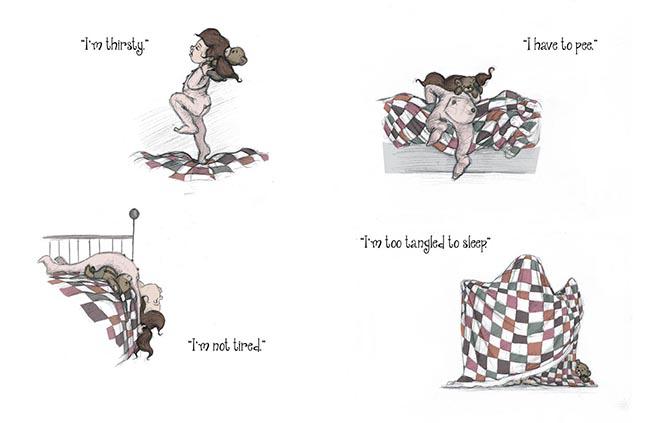
8. Character Flaws / Quirkiness – No one’s perfect, and usually the less perfect a character is, the funnier things get. The self-delusion of the little fish in Jon Klassen’s THIS IS NOT MY HAT cracks me up every time. Ditto for the conniving pigeon in Mo Willem’s DON’T LET THE PIGEON DRIVE THE BUS. And who can forget the pantless minor character, Mr. Crabtree, in Mac Barnett’s EXTRA YARN? I cannot.
9. Mashups – I’ll end with one of my favorite humor techniques — mashing together things that have no business being together. No one expects a lovelorn zombie in Kelly DiPucchio’s ZOMBIE IN LOVE. Or dinosaur pirates in my CAP’N REX & HIS CLEVER CREW.
Now get out there and craft some chortles, administer some amusement, and spread the smiles!
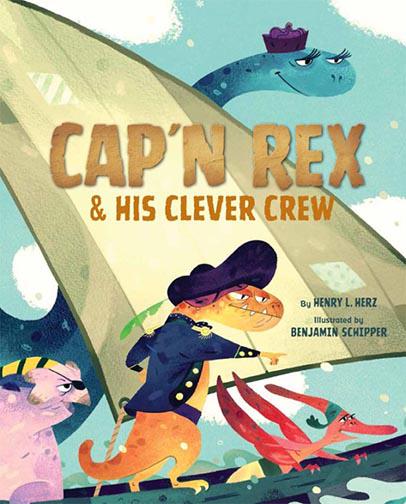
———-
Follow Henry:
Website: http://www.henryherz.com/
Twitter: https://twitter.com/HenryLHerz
Facebook: https://www.facebook.com/henry.herz/
Buy Henry’s Books:
http://images.henryherz.com/ecommerce/buy.html
-
Hippo Loves Larissa and Keith Marantz
May 8, 2020 /Larissa and Keith Marantz are the creators of the Clyde the Hippo series. They have worked together through four wonderful books. I realize now that I didn’t talk enough about Clyde the Hippo in this interview. It started with their child asking for a pet, and Keith saying that they didn’t need a pet, because they had a hippo in their back yard. Years later they worked together and came up a wonderful series with a hippo named Clyde! You can read more about their books here: http://clydethehippo.com
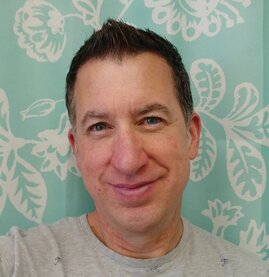
Keith Marantz Recently Larissa and Keith launched their book series in a virtual book launch party! It was so much fun. In some ways it was better than a bookstore book launch because I (and many other people including their agent) got to see the launch even though I live so far away.
Dani: How do you both work through ideas?
Larissa & Keith: Since we are a team, and we are married, ideas will happen at any time. Usually, Keith get his idea in the shower, and incidentally does a lot of his “writing” in the shower, too.
He’s more of the “idea guy” and I’m more of the “refiner” of the ideas. Although I have had a few ideas for stories that we’ve worked on. Clyde Lied was based off of my idea that he ended up writing ( and will be released in June, 2020). Basically, we’ll talk about our ideas during our evening walks with the dog, or during the day. If I get a visual idea in my head, I’ll draw a really rough sketch of it in my sketchbook. I’ve got quite a few stories that haven’t been developed yet that are still in rough sketch form in my sketchbooks. When Keith gets an idea, he’ll write it down and spend some time with it. If he thinks it’s promising, he’ll develop it into something to pitch to our agent. She lets us know if it’s worth spending the time to pursue or not.
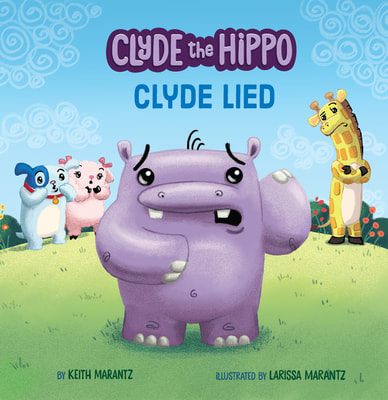
Cover of Clyde Lied 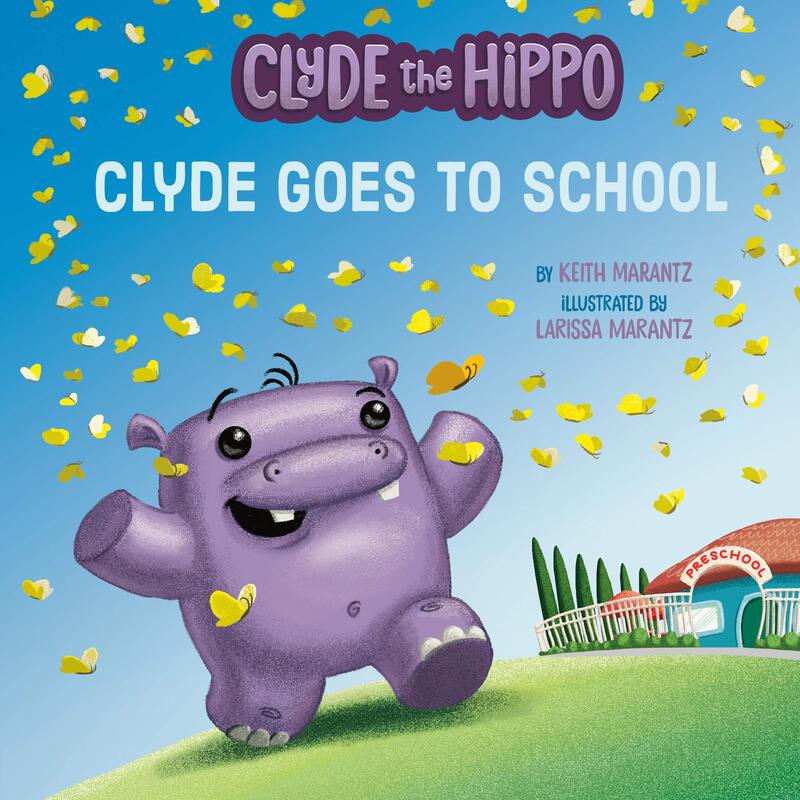
Cover of Clyde Goes to School Dani: What do you do when you aren’t working?
Larissa & Keith: Well, right now in this pandemic, we are doing pretty much the same as we did before. We both work from home, but when we’re not working, we’d usually hang out at the house, taking walks, or go get dessert with our kids. Now, we’re baking desserts at home. Keith is a phenomenal chef so he enjoys making delicious meals every night to keep the feeling of normalcy as much as possible. Except, now his meals have interesting names. The other night he made Hawaiian food and named it Lockdown Luau featuring Kovid Kalua Pork, Quarantine Cabbage and Mac-Corona Salad.
Yeah.
Dani: If there was a movie or song that describes your life, what would it be?
Larissa & Keith: I have no idea how to answer this but when I asked Keith he paused briefly and said “Ain’t No Stopping Us Now” by McFadden and Whitehead, 1979.
(Keith pulled that out of his head, him being a former DJ, knew exactly the song, the band and they year it was released.)
Dani: Any advice for working on projects with your significant other?
Larissa & Keith: Be open to criticism from your loved one and don’t take it personally when your partner makes suggestions for improvement. Remember that the project you’re working on is a team effort and the goal is to make it a success, and sometimes that means dropping your ego and not holding on to things that you want, but letting go and being open to possibilities. Know what your strengths are in the partnership and know what your weaknesses are so that you can each utilize your strengths and help each other out where the other needs help.
Yes, those are the rules we’ve set. But I have to admit that I’m still learning those rules. It’s very challenging at times, but conversely, it’s also extremely rewarding to know that together we are using the best of our abilities to make something we hope will make a mark in the literary world.
Dani: What projects do you have on the way?
Larissa & Keith: We are both working on our first graphic novel, BLAKE LASER, about a 12 year old inventor who must stop aliens from stealing the sun’s energy which would lead to the total destruction of Earth within 48 hours. It’s set in the 24th century and the main character has a fun relationship with her annoying older brother that will make this epic tale really relatable to readers. That, and we are trying to get through life in a pandemic. We’re lucky we have our health, our family, and an exciting challenging project to engage us during this time.
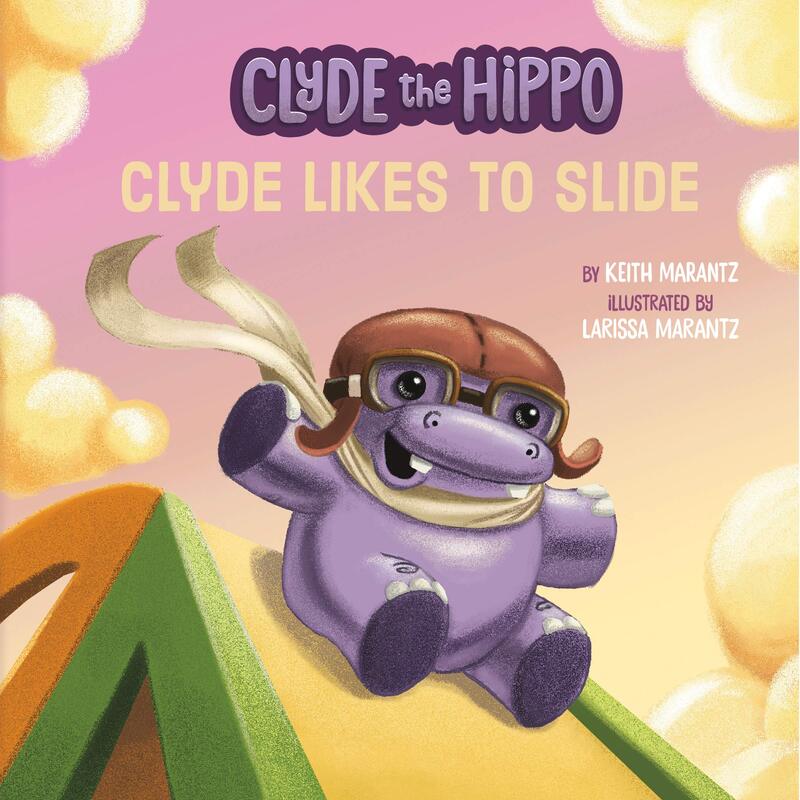
Cover of Clyde Likes to Slide 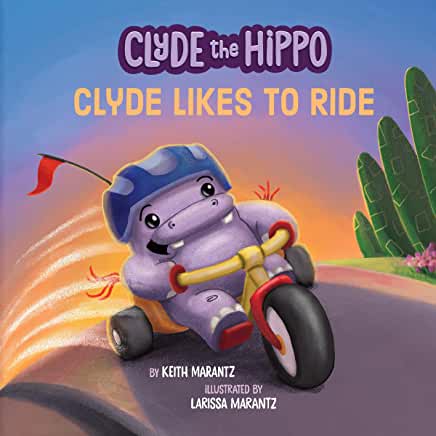
Cover of Clyde Likes to Ride Follow Larissa and Keith:
Buy Clyde the Hippo: BooksaMillion (More options on the webpage below)
Clyde The Hippo’s Website: http://clydethehippo.com
Larissa’s Website: http://larissamarantz.com/
Larissa’s Online Art Classes http://larissamarantz.com/oc-art-studios.html
Clyde the Hippo: https://twitter.com/clydethehippo
Larissa Marantz: https://twitter.com/LarissaMarantz
Keith Marantz: https://twitter.com/keith_marantz
